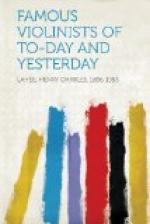Adolf Brodsky, who came to America in 1892, and who is a violinist of much ability, with a beautiful tone, facile and brilliant technique, but somewhat lacking in elegance and polish, did not come to tour the country as a virtuoso. He was engaged by Mr. Walter Damrosch as concert-master for the New York orchestra, but during his stay in this country he appeared in many of the most important concerts, and was considered one of the best violinists who had ever come to live in America.
Brodsky was born in 1851 at Taganrog, in Southern Russia, and was one of those who found his profession at the age of four, when he bought a violin at a fair, and began to pick out Russian folk-tunes.
For four years he was taught music at home, and made good progress. Then a wealthy gentleman was attracted by his talent, hearing him play at a concert at Odessa, and provided the funds necessary for him to go to Vienna and study under Hellmesberger. He became second violin in the celebrated Hellmesberger Quartet, and thus gained a great reputation as a quartet player.
After travelling all over Europe for four years, he was appointed second professor of the violin at the Conservatory of Moscow, where he remained another four years. Then followed more study and more travel until, when Schradieck accepted the position of violin teacher at the Cincinnati conservatory, Brodsky was appointed to fill his place at Leipzig. In 1892 he was called to New York, but, owing to troubles which arose in the musical profession, he returned to Europe the following year, and, after a short sojourn in Berlin, received the appointment of director of the Royal College of Music at Manchester, England, where he succeeded Sir Charles Halle.
Emil Sauret is well known in America, for he visited the United States in 1872-73, and made a tour which was so successful, that it was repeated in 1874, when he travelled with Ilma di Murska, the great singer, and his wife, Teresa Careno, the pianist.
[Illustration: EMIL SAURET]
Sauret began his public career at the age of eight. He was born at Dun-le-Roi, in the department of Cher, in France, in 1852, and at the age of six entered the conservatory at Strasburg, after some preliminary instruction at home. In two years he began his travels, and for several years he divided his time between study and travel.
As a boy he was taken up by De Beriot, who was much interested in his welfare. He studied under Vieuxtemps in Paris, and in 1872 was one of the artists engaged for the tour organised by the President of the French Republic for the relief of the sufferers by the Franco-German war.
In 1879 ne was appointed teacher at the Stern Conservatory in Berlin, a post which he relinquished on being offered the position made vacant in the Royal Academy of Music, London, by the death of Sainton.
M. Sauret is pronounced conservative and conscientious to the last degree in handling the classics, and, although he has great individuality, passion, and fire, he would consider it a sacrilege to obtrude his own personality upon the listener. He is distinguished for elegance rather than perfection of technique. He may be considered a representative of the extreme French school.




